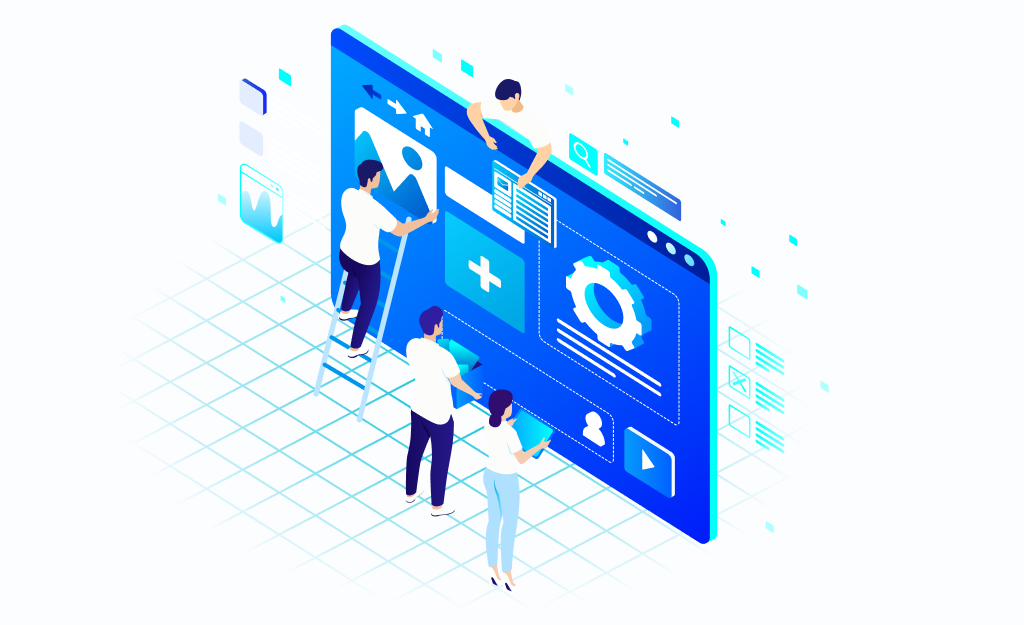The What, Why, and How of Modernizing Legacy Applications
The world does not stand still, and neither does the development of technologies. As businesses update their workflows and software users become pickier by the day, modern applications have to keep up to continue bringing value. One way to ensure this is by modernizing legacy applications — finding ways in which a particular software solution can become faster, more efficient, and more user-friendly.
Outdated apps not only fail to meet new business needs, but they are also complicated and costly to support and integrate with other systems built with the help of the latest technologies. Even if an enterprise had its corporate software custom-made for them some time ago, it may be considering modernizing it in a year or two. Here is a tendency spotted in 2022.
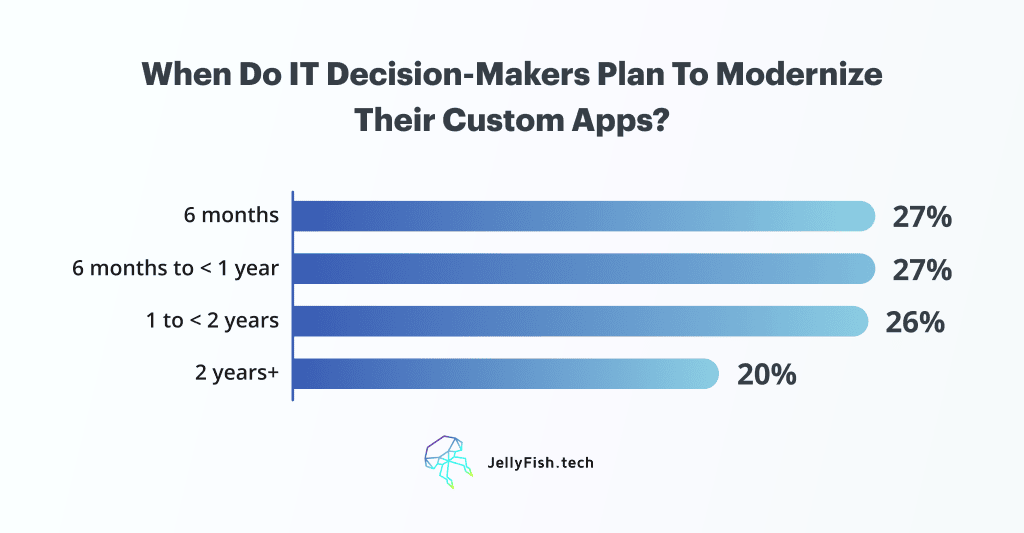
As a company with great experience in the modernization of legacy applications, we decided to dive deep into the topic to help you decide whether your software needs it and, if it does, which strategies to bet on for the best result. After all, everything new needs a solid foundation to be built on. Let’s see if software modernization is the answer your business might be looking for.
What Are Legacy Applications?
Legacy applications are outdated software programs that are still being used. It is usually due to the fact that they are linked to some critical business processes and are hard to replace. Such apps are often tied to a specific version of OS or programming language, but some organizations may be slow to modernize their legacy apps because:
- They still work. Most outdated systems are strongly integrated into the daily routines of the companies, employees are well-trained to use them, and changing such software does not always make sense.
- Modernization requires investment. While long-term utilization of a legacy app that does not meet the needs of a specific company can cost more than replacing it with a modern solution, some enterprises may not have immediate resources to invest in a new system. Moreover, it takes time and can lead to delays in some business processes, which is another factor that stops some organizations.
- Potential challenges. Sometimes companies may feel the need to modernize their software, but they do not have the expertise to do that and are wary of possible complications. Such updates also require retraining the staff or hiring new specialists and businesses decide to wait for better times.
However, as companies are moving forward and looking to adopt new tech solutions, they may experience some issues with old software since it requires manual maintenance and can cause system outages due to its lack of scalability and compatibility with newer systems. This leads us to common types of legacy applications that need modernization:
- End-of-life (EOL) systems refer to outdated software that has stopped bringing necessary benefits and has become too costly and time-consuming to maintain. These types of systems are often difficult or impossible to upgrade, as their developers may no longer support them or release updates. This leaves companies stuck with a solution that no longer meets their needs. In this case, businesses must decide if they should replace their EOL applications with new technology or simply retire them altogether. Whatever the decision may be, it is important to carefully evaluate EOL systems when considering an organization’s current and future IT strategies.
- Applications that are impossible to scale, which makes them unsuitable for long-term use. This is because they lack the necessary features to handle an increasing workload or a larger user base. Same as the previous type of legacy software, these apps must either be modified or replaced in order to satisfy evolving needs of a company.
- Heavily patched software. If a system has been serving an organization for a long time, it is often extensively patched. Developers do this to keep the software up to date and to correct defects, although heavy or incomplete parching usually leads to significant problems such as application instability and vulnerability to security breaches. When dealing with these types of software products, businesses should weigh the risk versus the reward of continuing to patch their existing systems. This process can take much time and adds on expenses, while there is often no guarantee that another patch will actually increase the app’s performance if the software is outdated.
- Applications that nobody in the team knows how to maintain. Sometimes there are only a few employees who know how to keep a legacy system working. When they leave the company, this knowledge is lost, especially when the tech documentation on this software is also missing. Then organizations are left with a choice — whether to hire a new IT specialist to supplement the lost expertise or opt for legacy application modernization.
How to Know When It Is Time to Modernize Your Legacy Application?
Deciding that a time has come for your company to replace or rewrite your outdated software might be challenging, as there are a lot of things to consider. So we consulted our experts in the field of modernizing legacy applications and compiled a concise list of questions that you can answer to know whether it is the right approach for your business.
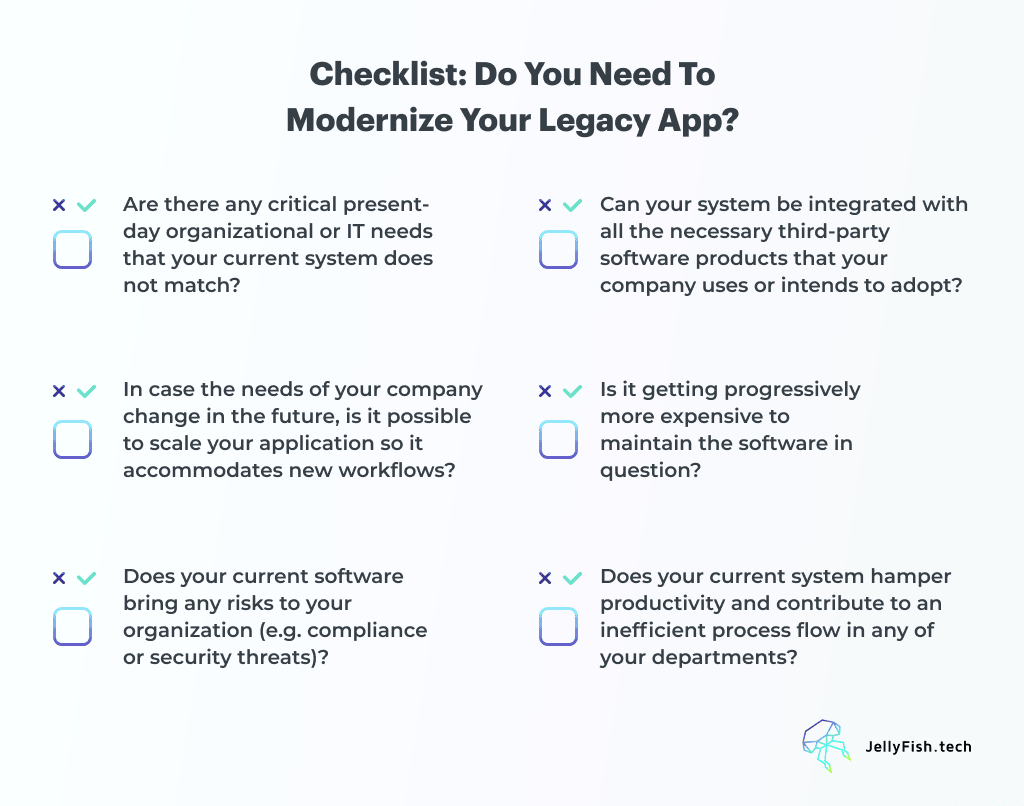
If you answered these questions and came to the conclusion that your current system does not fit some of your present or future requirements, it means that there is much room for improvement and updates.
Choosing Your Application Modernization Strategy
Although it may seem like a daunting task to modernize these systems, there are several strategies businesses can follow to keep their legacy systems up-to-date. The main strategies are:
- Rehosting
- Replatforming
- Rebuilding
- Rewriting
Each of these methods has its own advantages and drawbacks, so it is important to weigh all pros and cons. With the right strategy in place, you can ensure that your legacy application helps you achieve your specific business goals and allows your company to stay one step ahead of the competition. Let’s explore each of them in detail to help you decide which one will put you on the right track.
Rehosting
Rehosting legacy applications (or “Lift and Shift” strategy) means simply moving existing software to a more modern platform, such as from physical on-premise servers to a cloud service provider. This is a great solution for quickly and easily migrating your legacy systems while maintaining their functionality, as it encompasses little to no modifications in the code.
The primary reason to opt for rehosting is that it can be done quickly and at a low cost compared to other methods of modernizing legacy applications since the entire codebase of a system does not need to be rewritten. This is why organizations can take advantage of their legacy software’s existing features while still achieving the benefits of it being hosted on a new platform.
When to consider rehosting a legacy app?
- affordable price for the services of modernization is your priority;
- you need your software to be up and running as soon as possible after modernization;
- you would like to avoid retraining your employees in order to use a new version of your outdated system.
However, rehosting comes with some drawbacks. It doesn’t always provide full support for cutting-edge technologies, so companies may have limited choices when it comes to language, database, or cloud platform options. Additionally, it does not address any complex architectural issues that may exist in the codebase. So if your enterprise is dealing with such challenges, you might want to consider more complex application modernization strategies.
Replatforming
This method is similar to the previous one, yet replatforming (or ‘Lift and Reshape’ strategy ) involves introducing some changes to the legacy software’s code to boost its performance in the cloud. Even though this strategy does not encompass rewriting the app’s core architecture, the necessary updates enable organizations to use cloud-native features (e.g., auto-scalability) and allow the new version of the legacy system to fit into Agile DevOps processes.
When to consider replatforming a legacy app?
- you strive for improved scalability and easier maintenance of your system in the future;
- your business needs a faster modernization solution than a full-scale rewrite;
- you would like to decrease the cost of cloud-based services and improve convenience.
On the other hand, replatforming may require additional testing before launch due to differences in technology or programming language used to create a new version of a legacy app compared to the original one. There is always a chance that something could go wrong during the transition process, so choosing expert modernization services is a must.
Rebuilding
This strategy presupposes reconfiguration of the legacy app’s components to improve the existing system. Rebuilding is all about rethinking business specifications for the new version of the outdated software and changing the system’s logic. If your company still wants to use some of the components of your current legacy application, developers can rebuild them partially to preserve valuable features.
When to consider rebuilding a legacy app?
- you need to reimagine your current system to match new business needs;
- your enterprise is interested in saving on the project budget by preserving some of the elements of your legacy software;
- even if you need to change the architecture of your app completely, you still want it to be based on existing business requirements and user experience.
Talking about possible disadvantages of this application modernization approach, it is worth mentioning that rebuilding is time-consuming and requires a significant investment. However, if your company experiences a substantial gap between the capacities of your legacy software and your current needs, then this strategy is the answer.
Rewriting
Rewriting legacy applications means redoing their code from scratch. To successfully accomplish that, developers need to understand the logic of the outdated software and the business processes it serves. The best way to do this is to ensure that the development team can consult experts in this area, who will give them valuable recommendations on which features have to be incorporated into a new system.
When to consider rebuilding a legacy app?
- your business strives to adopt innovative technologies and has customized software that works specifically for you and can be scaled in the future;
- you would like to reevaluate your business processes and their efficiency;
- your enterprise and team are ready to wait longer for the launch of a new system
This approach to modernizing legacy applications takes the longest, as it also involves analysis of the outdated software’s codebase to fully understand its behavior and ensure that a new approach will not repeat the old mistakes.
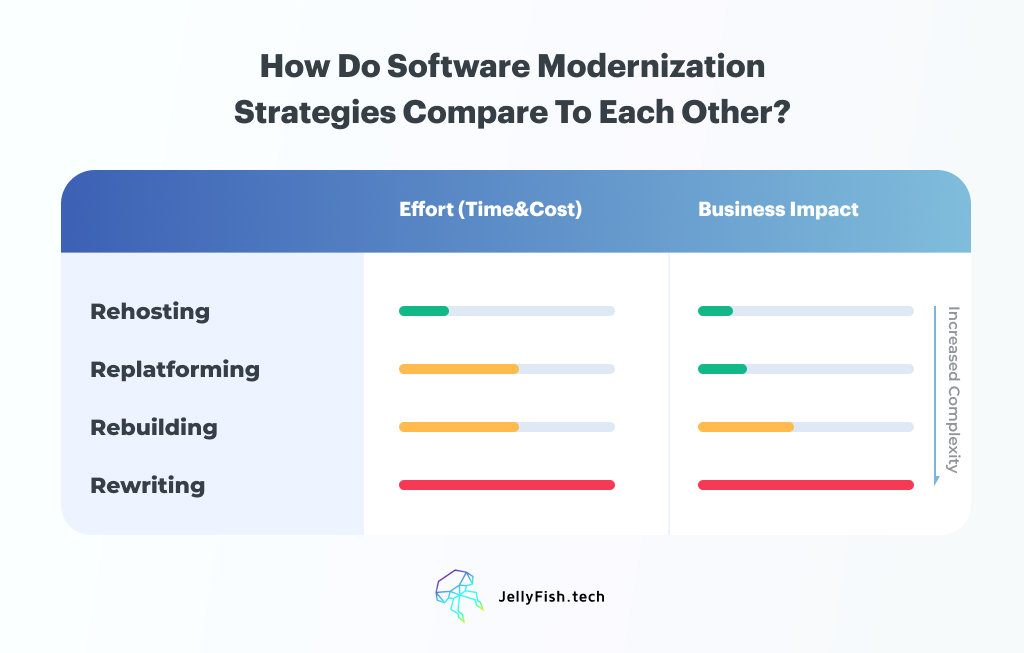
If you are not sure which application modernization approach meets your needs in the best way, don’t hesitate to contact us. Our experts will be happy to discuss everything in detail, evaluate the complexity of your legacy software, and recommend the most suitable strategy.
Trends of Modernizing Legacy Applications in 2023
The main trends of modernizing outdated software products in the year ahead will be the adoption of cloud-based technology, the use of artificial intelligence, and the exploitation of low-code platforms. Which benefits and changes will they bring to the evolution of legacy apps?
Leveraging the cloud-based technology
Cloud solutions offer a cost-effective, secure, and efficient way to keep up with the ever-changing demands of the digital landscape. They provide businesses with the ability to scale their applications quickly and easily. This scalability is especially beneficial for companies that need to update their old software to meet the requirements of a growing customer base or a new segment of the target audience. With cloud-based technology, businesses can quickly add more resources to their applications, such as storage, computing power, and bandwidth, without having to invest in additional hardware or software.
For example, cloud solutions can be used to create a virtualized environment that can run legacy applications without the need for costly upgrades. This can be done by leveraging existing cloud-based tools such as Amazon Web Services or Microsoft Azure. Additionally, such services can provide secure and reliable storage for data, allowing businesses to access their information from anywhere in the world.
Increased adoption of AI
AI has become an indispensable tool for legacy application modernization. With this technology, businesses can easily identify and eliminate outdated code, optimize existing codebase, and improve the overall performance of a software product. AI can also be used to provide predictive analysis, which can help to identify potential problems and offer solutions before they arise. Additionally, it can help to automate mundane tasks, freeing up time and resources of developers for more important activities.
AI-driven automation can be used to detect and correct errors in legacy applications, as well as to identify and address potential security threats. It also assists with analyzing user behavior and optimizing user experience, allowing businesses to deliver more personalized services to their customers.
Simplifying the process with low-code platforms
Low-code platforms are becoming increasingly popular for modernizing legacy applications as they provide a visual drag-and-drop interface that makes it easy to develop applications without writing complex code. By using the services of such platforms, organizations can quickly and easily build, deploy, and manage their software with minimal coding effort. For instance, a low-code solution can help companies add features such as mobile responsiveness or security enhancements to an existing application.
Moreover, these platforms come with a range of features that make it easy for organizations to manage their process of legacy application modernization. They include version control capabilities, so developers can easily track changes over time; built-in testing tools allowing teams to quickly debug and fix issues; and integration capabilities that make it easy to connect existing systems with new services or technologies.
Modernizing Mainframe Legacy Applications
There are a lot of companies that still use their mainframe legacy applications because they are often connected to some critical business processes and vital for continued success. However, without necessary upgrades, these outdated software systems can cause a number of issues, such as high maintenance costs, slow performance, and lack of flexibility.
Driven by the need to keep up with ever-changing customer demands, stay competitive, and maximize efficiency, businesses have started considering the modernization of mainframe apps. After choosing a fitting strategy (whether rehosting, replatforming, rebuilding, or rewriting), organizations take their core business activities to the next level by achieving the following benefits:
1. Mitigating security risks
As technological advances in software development progress, many businesses are facing the challenge of how to mitigate security risks with the modernization of legacy software. Outdated software solutions are vulnerable to modern cyber-attacks, leaving organizations exposed and at risk for data breaches. The increasing demand for new features, along with the need for continuous maintenance, makes it difficult to keep up with today’s ever-evolving threat landscape.
Modernization is becoming more attractive as an option due to its cost-effectiveness and scalability but it also comes with its own set of unique challenges, such as maintaining compatibility between different systems and ensuring that any changes introduced to the software product do not lead to new security vulnerabilities. Nevertheless, the modernization of legacy applications helps protect them from potential cyber-attacks that may result in serious issues such as customer and data loss.
2. Increased efficiency and productivity
As more businesses are embracing digital transformation, the need for legacy applications to be updated with modern solutions has become increasingly important. Legacy application modernization helps organizations achieve better efficiency and productivity by utilizing new technologies that can improve workflow processes, reduce manual effort and accelerate time-consuming tasks.
By improving productivity, modernizing outdated software systems can also help enterprises gain a competitive edge in the market and conduct business processes smoothly, without failures.
3. Cutting expenses
Modernization of legacy systems is essential for enterprises looking to save costs. Legacy systems are the backbone of many businesses, but the technology used to build them is often out of date and no longer relevant to the particular business needs of a company. Modernizing legacy applications allows businesses to remain competitive while saving costs in the process.
By using updated technology, organizations can reduce the amount of effort and resources needed to keep the application up and running. This means less time and money spent on maintenance and repairs, and more resources available to focus on other areas of the business. For many companies, the challenge of modernization lies in the complexity of legacy applications and the cost associated with upgrading and maintaining them. However, the long-term benefits of modernization far outweigh the initial cost of implementation.
4. More pleasant customer experience
One of the biggest advantages of legacy application modernization is that this practice helps businesses provide better customer experiences. Companies that invest in upgrading their legacy systems are more likely to have better customer satisfaction, faster response times, and higher customer retention rates. By using the latest technology, businesses can provide customers with a more intuitive and user-friendly experience.
Equipping customers with better tools and more efficient processes means helping them get the most out of their products and services. Additionally, modernization can help businesses better understand their customers’ needs, enabling them to provide better customer service and support.
5. Higher ROI
By investing in the modernization of legacy applications, companies are able to transition their existing systems, applications, and processes to new and more modern technologies. This provides enterprises with more features and capabilities to better respond to customer needs while also reducing their operational costs. For business executives, this is a crucial step to maximizing Return on Investment (ROI).
By investing in the modernization of their applications, organizations unlock their potential and gain access to valuable customer data, which can then be used to create better marketing strategies and drive revenue.

How to Choose Legacy Application Modernization Services?
Company executives are often challenged with the task of upgrading their outdated software systems while ensuring business continuity. With the right services, you can improve the performance and scalability of your legacy applications, eliminate the need for costly upgrades, and make sure that your organization’s data remains up-to-date and secure.
When considering a potential partnership with a modernization services provider, it is important to take into account the complexity of your current system, the goals of the process, and the available resources. Here are five key steps to selecting the right modernization services for your legacy applications:
1. Understand your existing system: before selecting a provider of legacy applications modernization services, it is necessary to understand the existing system and its current capabilities. This will help you identify areas for improvement and understand the scope of the project.
2. Define your goals: it is essential to determine the goals you want to achieve with your modernization project. Consider the future of your business and what you need in order to reach those goals. Setting up clear goals will also help you determine the right service provider for the job. For example, if you are looking to modernize an outdated application, you may want to look into services that specialize in web and mobile applications.
3. Investigate your options: research potential modernization services vendors to understand their capabilities, experience, and pricing. Pay attention to customer reviews and project portfolios to make sure that the service provider is a good fit for your organization’s needs. Assessing the provider’s expertise in legacy applications modernization also plays a significant role. Ensure that they have a proven track record of successful projects and can provide references from previous clients.
4. Establish a budget: when evaluating the various modernization services, it is crucial to consider the cost associated with the services. It is important to determine the overall cost and then compare it to the value that the services will bring to your business. Additionally, you should weigh the time it will take to implement the modernization and any additional expenses that may be associated with the process.
5. Evaluate support: when selecting modernization services for your outdated system, you need to look for vendors that are willing to provide ongoing support and maintenance. This will ensure that your business continues to stay up to date with the latest technologies and that your modernization efforts remain effective.
By following these five simple tips, you can make sure that you are selecting the right legacy applications modernization services for your business. Researching and evaluating the options available on the market will help you ensure that your enterprise is able to keep up with the ever-evolving technology landscape.
Leading Businesses to The Future: Our App Modernization Case Studies
As a trusted provider of application modernization services, Jellyfish.tech strives to lead by example. Take a look at two of our successful cases when we collaborated with our clients on reviving their software and making it suitable for their needs again.
Modernization of a platform for dog daycare
HappyDogs is an amazing application that offers dog daycare, pick-up/drop-off options, baths, and boarding services. It was a classic case when our client needed to upgrade their platform and boost user experience.

To modernize this useful pet care application, our team updated the versions of Django and Python that were used to build the product to the latest versions. We also noticed there were several software libraries that were not supported anymore and fixed this issue too. Our full-stack developer also implemented a new daycare template, which was more user-friendly for both dog owners and the platform’s staff to schedule the time when the dogs had to be picked up or dropped off, as well as other activities with the pets. Our team also covered the whole codebase of the app with unit tests.
As a result, we upgraded the application and improved its functionality and performance. This made it as easy as possible for the platform’s employees to accept requests from their users and for dog owners to be sure that their pets receive the best care.
Migrating a project & portfolio management tool from JavaScript to Angular 9
Zeno.PM has been our long-term partner for more than 6 years now. We first started our collaboration when the team needed to implement a new functionality for their project and portfolio management application. Since then, we have built a strong partnership, and we continue working on improving their solution to this day.
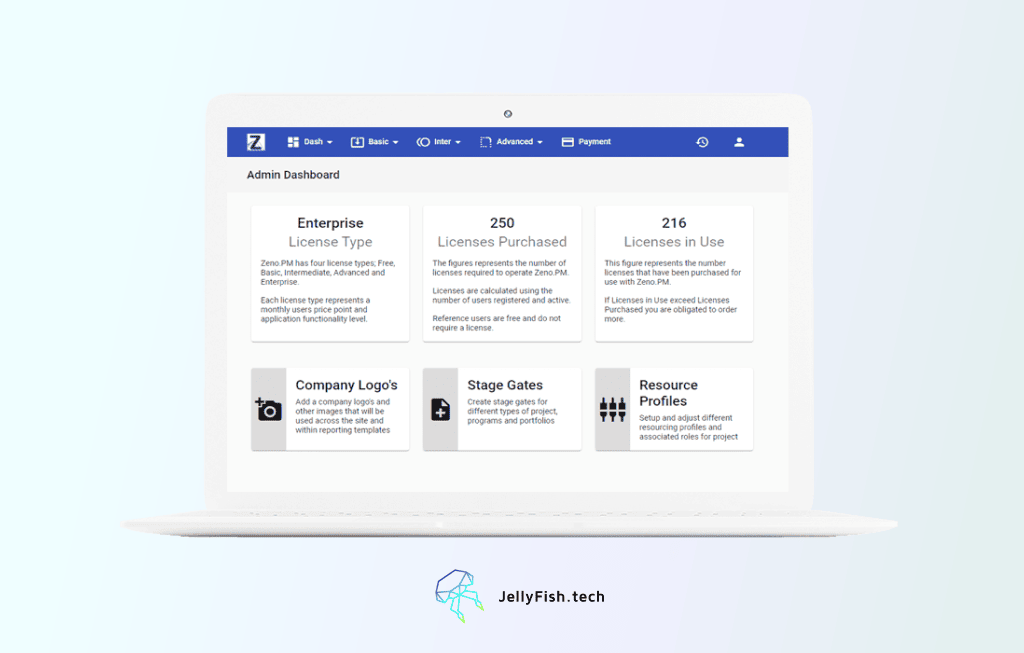
Over the time of our partnership, we have modernized and improved the tool by adding Home Dashboard functionality that allows tracking of every product, their due dates and statuses; Admin Panel, which facilitated the customization of the app to the organization’s needs; Resource management system and Kanban board to monitor the availability of team members on the project and keep track of their tasks, and many other features.
At the moment, we’re working on upgrading the old functionality and migrating the application parts from pure JavaScript to Angular 9.
How Do We Approach the Modernization of Legacy Software?
Whichever business processes your legacy system or application serves, there are several steps and best practices that are important to follow to ensure that its new version meets all requirements of your organization. In order for your investment in modernization to bring the necessary results, there are a lot of things to consider before and during the process.
The first step to modernizing legacy software is to assess the existing system. This involves taking a look at the current architecture, infrastructure, and codebase of the system. It is also crucial to pay attention to the outdated software’s user interface, functionality, and user experience to determine what needs to be updated or replaced. Do not forget to gather feedback from the team that uses the software to outline the gap between the system they currently use and their actual needs.
Once you have identified the areas of the software that need to be updated, the next step is to determine the best approach to modernizing the legacy software. And after that, it is time to compile and implement a modernization plan. Each of these tasks requires much time, effort, and expertise, so choosing an experienced team of developers is the key to success.
Jellyfish.tech can provide you with tangible results at every stage of preparation and implementation processes. After our successful collaboration on previous software modernization projects, we have developed a precise and effective roadmap aimed at thorough analysis and fulfillment of our client’s needs. Here is our step-by-step approach to modernizing legacy applications:

Step 1. Architecture Audit
Software architecture assessment is at the core of preparing a plan for the modernization of a legacy system. This involves examining the overall structure of the system, the choice of programming language, the database design, security protocols, user interface design, and other important elements. We conduct such an audit to detect the gap in the software design and structure in order to ensure that the modernized version is fit for its purpose.
Step 2. Code Audit
As a reliable provider of software modernization services, we understand the importance of assessing software code for quality, reliability, and accuracy. It can be done manually or with the help of automation tools to save time and prevent human error. The process of code audit encompasses checking the structure of the code, how it is organized, and how it flows from one section to another. This can help to identify potential bugs and areas where the code may need to be improved or refactored.
It also makes sense to look at the coding style and conventions used within the outdated software. This includes evaluating the syntax and formatting of the code, as well as any coding patterns that might have been used. Such an audit allows the team to identify potential areas of improvement, for example, proper commentation and indentation, which can help to keep the codebase consistent and organized.
Step 3. Rehosting/Replatforming/Rebuilding/Rewriting
This is the stage when we implement an application modernization strategy, which we have chosen and approved together for your software. The time it takes for an application to be modernized depends on a few factors. This includes the size of the application, the complexity of the migration process, the destination environment, and the level of effort required to implement the new system.
For small applications, the modernization process can take as little as a few weeks. For larger applications, it can last from several months up to a year. The time required also depends on the complexity of the process. For example, if the application needs to be rebuilt from the ground up or completely rewritten, the timeline will be extended.
Step 4. Performance testing
After building and migrating a new version of your legacy software, our team will make sure that it is stable, has high performance, and does not consume too many resources by conducting performance testing. This type of QA activity helps to ensure that the modernized app performs as expected after all the modifications. The main goal of performance testing is to check the speed and accuracy of software when it is running after different conditions, such as high or rapidly changing loads (the number of simultaneous users), unstable internet connection, and others.
Step 5. Quality assurance
At the end of each development sprint, our team performs unit testing — verification of separate pieces of code. To save time and manual effort during this process, our specialists automate unit tests by creating scripts and running them in relevant automation frameworks. One more benefit of automated unit testing is that developers can perform multiple checks simultaneously and receive quick and accurate feedback on the state of their code.
Unit testing is the basis for further, more complex types of QA activities, as they help to ensure that changes to the code do not break the already existing functionality of a software product.
The Time for Modernization Is Here
Modernizing legacy applications is a great way to make sure that your business can keep up with the fast-paced world of technology. By refactoring and updating outdated software systems, businesses can take advantage of new frameworks and technologies to help them operate more efficiently. Additionally, the modernization of old solutions also helps to prevent costly security vulnerabilities that can create serious obstacles for a company’s workflows and even ruin its business reputation.
Overall, the modernization of legacy applications is an important step for any business looking to stay competitive in today’s digital landscape. To get started on this process, it is important to first assess what needs updating and determine if the cost outweighs the benefit. Once those decisions are made, businesses should reach out to qualified professionals who specialize in application modernization and refactoring services so they can properly review their existing systems and create a plan for moving forward safely and securely.
If you think that it may be high time to power your legacy software with innovative technology, enrich it with new functionality, and give it a new life, so it becomes a valuable tool for your organization again — let Jellyfish.tech take care of this process from A to Z. Our experts will estimate the current state of your legacy system or application, recommend the most efficient strategies for modernization and select suitable tech stack to upgrade your software to the next level.

